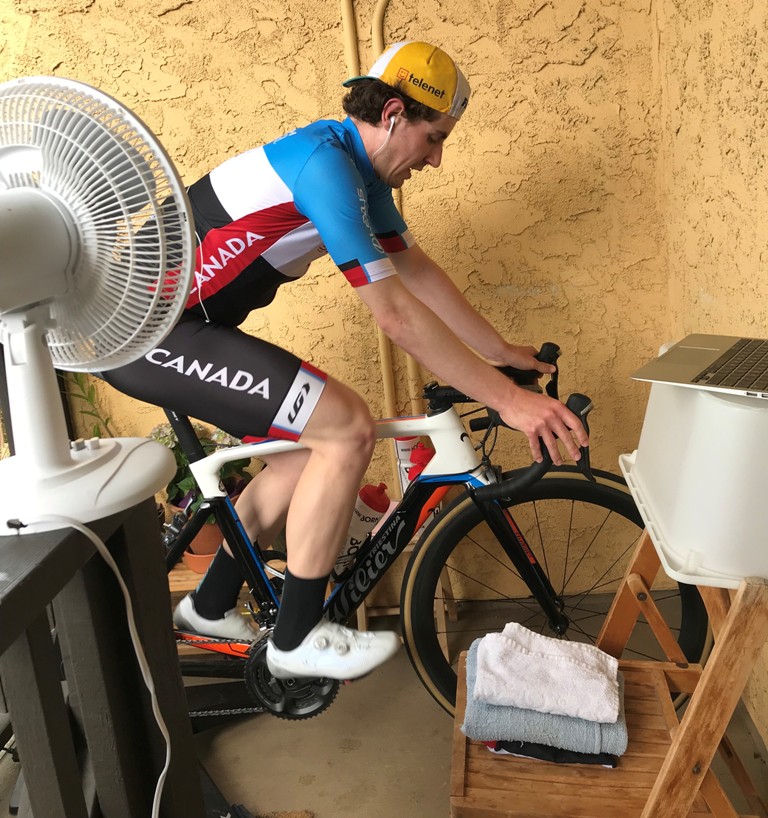PCC Athlete adapting to Indoor Training

PCC athletes are adapting to the ‘new normal’ we find ourselves in. Creating a new routine of training indoors takes adjusting particularly if you are used to training on the road year-round. Amiel Flett-Brown – who won a Bronze medal in the Team Pursuit at the Track Worlds in January – is finding a way how to stay fit with while keeping safe and healthy. It is giving him the opportunity to work on his strengths and weaknesses and with the change of pace he feels he will come out of it all a better athlete.
Amiel shares his routine and how he is making indoor training fun and challenging.
I’ve found that overcoming mental barriers are the most common occurrences that may hinder my training routine. Creating tasks, schedules and routine have helped me stay on track with my fitness.
- Showing up – often a majority of mental barriers can be overridden by simply getting on the bike. I try to set a realistic time of day that I will start training and either set my bike up the night before or just after breakfast when I have some free time. Having the mental clarity that all you have to do is get on the bike, helps to simplify things.
- Having nutrition ready – depending on the energy demands of my training, another one of the things I do is prepare my nutrition before I get on the bike. The nice thing about indoor training is that you don’t have to keep your food in your pockets. For example, instead of eating a packaged fig newton bar, you could have a jam sandwich (on a plate). Hydration is largely more important than we may be used to, even if you have the latest cooling systems in place, you will still likely need to add at least an extra 500-1000ml of fluid to your ride plan. I like to set up a table with all of my hydration needs, including a post ride recovery drink in the ready. That way, you don’t have to get off the bike too often and can keep the quality of your training high.
- Warming up and cooling down – preparing physically and mentally are both two of the most important factors for me. If you’ve ever heard of the Pavlovian Response “a learning procedure that involves pairing a stimulus with a conditioned response.” I like to think of my warm up routine (breath work, muscle activations, on bike warm up) and cool down as an actual procedure to prepare my mind (and body) for the riggers of training. The more frequent positive experiences I have training, the more my mind and body will associate training with being happy. If you’re having a tough day, look at what you can improve for next time and consider what you did that made you feel good and add that to your routine!
- Keep the stimulus simple – there are a lot of things to focus on while riding these days, some good and some less helpful. For me, I tend to have a busy mind when I begin to suffer, say in an interval for example. The more internal noise, the less I am able to focus on the effort. If you can find a way to pair down your distractions and amplify the ones that really count you may find that the RPE of doing an effort indoors will go down. Another example; do you need your Garmin screen to tell you what the temperature is during your interval? Or do you need to be watching YouTube, Zwift and listening to an audiobook while doing a threshold interval? Finding ways to simplify your external input may help with focus. If I have a hard training session I keep my screen to a maximum of three data fields, find a good song or playlist. Virtual riding is good for this too! But keep it simple. This may be an acquired taste, but I actually like to have a blank wall to look at and Zwift off to the side. I’ll also let those who I am living with know that I am going to be doing a hard session so not to interrupt if possible. This may be harder for those with children, so finding time when kids are occupied could be the most optimal time for intervals. You can always talk about lightsabers and Frozen during a zone 2 ride.
- Flexibility – not just in the muscles, but in your planning and mindset. These are not optimal times and there will be many things you cannot control but you are always going to be responsible for your mindset. If something is blocking you from getting everything that you wanted to get done in the day, take a step back and consider what has gone right in your day. I try to stay grounded to the idea that I am grateful to be healthy, mobile and able to train on a regular basis. That is something that I can always come back to when things are not going to plan. Having the plan is one part, being able to adjust based on experience is key to enjoying your time training. A better snapshot of the trainer set up.
